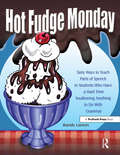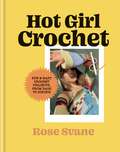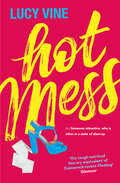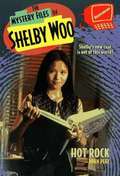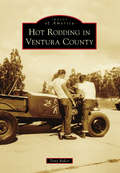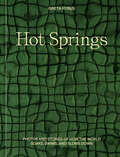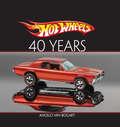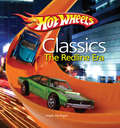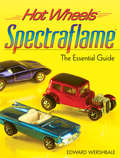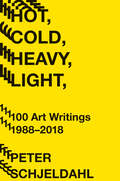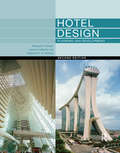- Table View
- List View
Hot Fudge Monday: Tasty Ways to Teach Parts of Speech to Students Who Have a Hard Time Swallowing Anything to Do With Grammar (Grades 7-12)
by Randy LarsonHard as it is to believe, teachers tell us all of the time that their students actually ask to do the funny, wacky activities from Hot Fudge Monday.This new, expanded edition of our best-selling book offers even more tasty ways to teach parts of speech, including quirky quizzes, extended writing activities, and Internet enrichment activities that reinforce new skills.Hot Fudge Monday joins the study of words to the process of writing those words into meaningful sentences. The book consists of eight chapters, each one dealing with one part of speech. Students learn about the various parts of speech through short writing activities that are interesting, humorous, and a bit offbeat.Grades 7-12
Hot Girl Crochet
by Rose SvaneContemporary crochet star Rose Svane will teach you how to crochet your own cool clothes, accessories and Scandi homeware.With a calm, creative vibe, this is the perfect guide for complete beginners, and those who've already caught the crochet bug.Start with a crash-course in the key skills, then move on to 15 stunning step-by-step projects, from a tote bag and a bucket hat, to a plant basket and a cute bikini. Once you've got to grips with the techniques, you'll find that crochet can be a very mindful practice, and you'll soon have an essential new calming and creative outlet.In just a couple of years, crochet designer and author Rose Svane has created a global business whose customers count influencers Emma Chamberlain, Maddie Ziegler, and Meadow Walker. Her designs have been featured in Cosmopolitan and copied by people all over the world.
Hot Girl Crochet
by Rose SvaneContemporary crochet star Rose Svane will teach you how to crochet your own cool clothes, accessories and Scandi homeware.With a calm, creative vibe, this is the perfect guide for complete beginners, and those who've already caught the crochet bug.Start with a crash-course in the key skills, then move on to 15 stunning step-by-step projects, from a tote bag and a bucket hat, to a plant basket and a cute bikini. Once you've got to grips with the techniques, you'll find that crochet can be a very mindful practice, and you'll soon have an essential new calming and creative outlet.In just a couple of years, crochet designer and author Rose Svane has created a global business whose customers count influencers Emma Chamberlain, Maddie Ziegler, and Meadow Walker. Her designs have been featured in Cosmopolitan and copied by people all over the world.
Hot Glue Hacks and Crafts: 50 Fun and Creative Decor, Fashion, Gift and Holiday Projects to Make with Your Glue Gun
by Angie Holden Carolina MooreFifty amazingly creative things you can do with your glue gun—includes projects kids can help with too!Filled with color photos and easy-to-follow step-by-step instructions—plus safety tips and helpful information on equipment and supplies—Hot Glue Hacks and Crafts shows how to create unique and fun projects from a wide variety of stylish glues. Discover:• Imaginative Ideas for Kids• Fun and Artistic Hacks• Seasonal Decorations• Holiday-Themed Crafts• Creative Decor• Cute Party Ideas
Hot Mess: Bridget Jones for a new generation
by Lucy VineHot Mess [n.] - someone attractive, who is often in disarray.Have you ever shown up to Sunday brunch still smelling of Saturday night?Chosen bed, Netflix and pizza over human contact?Stayed in your mould-ridden flat because it's cheap?Meet your spirit animal, Ellie Knight. Her life isn't turning out exactly as she planned. She hates her job, her friends are coupling up and settling down, and her flatmates are just plain weird.Some people might say she's a hot mess but who really has their sh*t together anyway? For fans of Fleabag and Girls, this is a fresh and funny coming-of-age story with a single-girl heroine that will speak to millennials everywhere.Everyone is talking about Hot Mess - the hilarious laugh-out-loud Bridget Jones for a new generation:'More lifestyle-affirming than Bridget Jones' Sarah Knight, author of The Life Changing Magic of Not Giving a F*ck'If you love dirty jokes, dating horror stories and hilarious dialogue, this book is for you' Emma Gannon, author and podcast host of Ctrl Alt Delete'I laughed and sighed with recognition as I turned every page' Daisy Buchanan, author of How To Be a Grown-UpRead by Elisabeth Hopper(p) Orion Publishing Group 2017
Hot Mess: The utterly hilarious and relatable Number One eBook bestseller
by Lucy VineThe eBook Number One bestseller The hottest book of the summer. A sassy, laugh out loud beach read everyone is talking about *****Hot Mess [n.] - someone attractive, who is often in disarray.Have you ever shown up to Sunday brunch still smelling of Saturday night?Chosen bed, Netflix and pizza over human contact?Stayed in your mould-ridden flat because it's cheap?Meet your spirit animal, Ellie Knight. Her life isn't turning out exactly as she planned. She hates her job, her friends are coupling up and settling down, and her flatmates are just plain weird.Some people might say she's a hot mess but who really has their sh*t together anyway? For fans of Fleabag and Girls, this is a fresh and funny coming-of-age story with a single-girl heroine that will speak to millennials everywhere.*****'The laugh-out-loud literary equivalent of Trainwreck-meets-Fleabag' Glamour'A breath of fresh air, deftly subverting some of chick lit's biggest clichés' Stylist'More lifestyle-affirming than Bridget Jones' Sarah Knight, author of The Life Changing Magic of Not Giving a F*ck'If you love dirty jokes, dating horror stories and hilarious dialogue, this book is for you' Emma Gannon, author and podcast host of Ctrl Alt Delete'I laughed and sighed with recognition as I turned every page' Daisy Buchanan, author of How To Be a Grown-Up
Hot Metal: A Complete Guide to the Metal Casting of Sculpture
by Wayne PotratzThis book, in it sixth edition, has evolved over the years into a complete guide to the metalcasting of sculpture. Potratz (Ironwain) has taken his years of knowledge gained practicing and teaching his craft and is now sharing it all in this easy-to-use book. Contents include: Introduction to Metal Casting, Recommended Tools and Equipment, Safety, Pattern Making, Sprueing and Venting Wax, Intro to Molding, Melting and Pouring Metal, Chasing, and Patina of Metals. Includes a comprehensive bibliography; an appendix filled with useful conversions, charts, recipes, and cupola/cupolette furnace building specs; detailed index; and much, much, more.,
Hot Pink: The Life and Fashions of Elsa Schiaparelli
by Susan Goldman RubinShocking pink—hot pink, as it is called today—was the signature color of Elsa Schiaparelli (1890–1973) and perhaps her greatest contribution to the fashion world. Schiaparelli was one of the most innovative designers in the early 20th century. Many design elements that are taken for granted today she created and brought to the forefront of fashion. She is credited with many firsts: trompe l’oeil sweaters with collars and bows knitted in; wedge heels; shoulder bags; and even the concept of a runway show for presenting collections. Hot Pink—printed with a fifth color, hot pink!—explores Schiaparelli’s childhood in Rome, her introduction to high fashion in Paris, and her swift rise to success collaborating with surrealist and cubist artists like Salvador Dalí and Jean Cocteau. The book includes an author’s note, a list of museums and websites where you can find Schiaparelli’s fashions, endnotes, a bibliography, and an index.
Hot Rock (The Mystery Files of Shelby Woo, #3)
by John PeelFirst the Mars rock at the Space Museum disappears, then $500,000 worth of gems. It's up to Shelby and her friends, Cindi and Noah, to crack the case.
Hot Rodding in Santa Barbara County (Images of America)
by Tony BakerCalifornia's central coast was fertile ground for hot rodding, and all motor sports in general, during the 1940s and 1950s. Hot Rodding in Santa Barbara County takes the reader back in time with a collection of remarkable photographs from the earliest days of the hot rod movement. This book includes images of the first drag strips in the country, rough-and-tumble jalopy racing, early road-racing action, and lots of great hot rods and customs. Follow local hot-rodders as they take trips to El Mirage dry lake and the world-famous salt flats at Bonneville, Utah, and visit a long-lost world as seen through photographs taken from the personal albums of people who contributed to the birth of a culture that would spread across the nation.
Hot Rodding in Ventura County (Images of America)
by Tony BakerStretching from Ventura to Santa Maria, California, a vibrant and colorful community of hot rod clubs bloomed throughout the middle of the 20th century. Hot Rodding in Ventura County takes a look at the people, places, and, above all, the cars that made up this historic period in automotive culture. Take a look into the golden years of hot rodding through vintage images of the first national championship drag races; visit long-lost drag strips such as Goleta, Saugus, and Santa Maria; and gain access to hot rodding's paramount clubs like the Motor Monarchs, the Kustomeers, and the Pharaohs.
Hot Springs, Arkansas (Images of America)
by Ray Hanley Steven HanleyFrom its rise in the 1800s until well into the twentieth century, Hot Springs was a famed resort known worldwide. The grand hotels and world-class bath houses that sprang up around the government-protected springs drew countless visitors, ranging from the famous and wealthy to those of humble means, all seeking the health and pleasure promised by the Spa City's promoters. In the words of a railroad tourist guidebook from about 1910, "A stay at Hot Springs, be it ever so brief, always remains a pleasant memory afterward. It was the writer's good fortune to spend a few days at this popular resort--not as an invalid, I am happy to say, but as a tourist--and I certainly never bathed in more delightful water than that which flows so abundantly from the hot springs of Arkansas. There is buoyancy, a magnetism about it that is simply indescribable."Such has been the experience of countless visitors over the years. Readers will find much of the history of this storied resort in Hot Springs, Arkansas, which is profusely illustrated with vintage postcards and photographs, all carefully interpreted by the authors, Ray and Steven Hanley, with research assistance from Mark Blaeuer of the Hot Springs National Park staff.
Hot Springs, Arkansas in Vintage Postcards (Postcard History Series)
by Ray Hanley Steven G. HanleyFrom the 1890s to the 1920s, the postcard was an extraordinarily popular means of communication, and many of the postcards produced during this "golden age" can today be considered works of art. Early in the century, Hot Springs was among the most noted resorts in the nation. Its Victorian wonders drew thousands of visitors to partake in the hot mineral waters that bubbled from the earth. In the words written on one card in 1910, "Many people of wealth are here from Chicago and New York. Uncle Billy went to the horse show ball at the Eastman Hotel with an ex-wife of a millionaire. Andrew Carnegie and young Jay Gould were at the ball." Showcased in this fascinating collection are over two hundred postcardsfrom 1900 to 1960. The images are accompanied by the actual penned messages of visitors and extensively researched historical facts.
Hot Springs: Photos and Stories of How the World Soaks, Swims, and Slows Down
by Greta RybusImmerse yourself in hot springs from around the world in this stunning visual adventure that features photographs and stories of the unique topographies, regional uses, and cultural meanings of thermal baths.This book transports you to high mountains, remote islands, vast deserts, and the Arctic to soak in the ethereal beauty of natural hot springs. From sacred sites in India to municipal pools in Iceland and beyond, photojournalist Greta Rybus has traveled the world to document the warm, wild gathering places that have comforted the weary and adventurous for centuries. Each spring is unique, a reflection of not just its physical location but of the people who care for and enjoy it. Hot Springs guides you through breathtaking landscapes and offers intriguing insights on historical significance, proper etiquette, and the roles these springs have in their communities. You&’ll hear from bathers in Hungary and Japan about how hot baths are a consistent part of their wellness and social routines. You&’ll learn about a repatriated hot spring in South Africa and explore the power of communal ownership for locals in Alaska, Greenland, and Mexico. You&’ll read about a pool that Antony reportedly gave to Cleopatra and hot springs in Iceland still connected to an outlaw past.Greta&’s breathtaking photography transports you to more than two dozen worldwide locations while introducing you to the interconnected communities surrounding them. Hot Springs is your invitation to revel in the healing powers of water and its ability to connect us to ourselves, others, and the planet.
Hot Stamping Advanced Manufacturing Technology of Lightweight Car Body
by Bin He Ping Hu Liang YingThis book summarizes the advanced manufacturing technology of original innovations in hot stamping of lightweight car body. A detailed description of the technical system and basic knowledge of sheet metal forming is given, which helps readers quickly understand the relevant knowledge in the field. Emphasis has been placed on the independently developed hot stamping process and equipment, which help describe the theoretical and experimental research on key problems involving stress field, thermal field and phase transformation field in hot stamping process. Also, a description of the formability at elevated temperature and the numerical simulation algorithms for high strength steel hot stamping is given in combination with the experiments. Finally, the book presents some application cases of hot stamping technology such as the lightweight car body design using hot stamping components and gradient hardness components, and the cooling design of the stamping tool. This book is intended for researchers, engineers and graduate students in vehicle engineering, mechanical engineering, especially in the field of advanced manufacturing technology. The book also provides a useful reference for other new technology related temperature and phase transformation, such as aluminum-magnesium alloy hot stamping.
Hot Wheels Forty Years (Hot Wheels (krause Publications) Ser.)
by Angelo VanbogartIf you're a collector of the ultra-cool, sensationally sleek and super speedy Hot Wheels, you are in for a treat with Hot Wheels: Forty Years. This big, beautiful coffee table book tells the story of these miniature marvels through more than 600 stunning color photos, and historical details including company history, interviews with Mattel designers, major developments and trends. All the attitude and innovation of these revolutionary pocket-sized racers, Redlines, Blackwalls, Number Pack Vehicles, Protypes and more, is captures in the pages of this must-have reference.
Hot Wheels Accessories: The Ultimate Guide (Hot Wheels Accessories: The Ultimate Guide Ser.)
by Michael ZarnockWith one Hot Wheels sold every six seconds, these childhood favorites remain a hot ticket collectible, and a resource devoted to Hot Wheels accessories is a must-have for any fan of these sleek and speedy roadsters. Every accessory produced since 1968 to 1998 is included in this comprehensive reference. Detailed listings, with up-to-date prices, cover various accessories including play, gift and track sets; superchargers; buttons; Christmas ornaments; puzzles and trading cards' and lunch boxes. Packed with more than 425 stunning color photos and listings for vintage and modern accessories, this book is a must-have for any Hot Wheels enthusiast. 425+ color photos for easy identification Listings for 30 years of Hot Wheels accessories Most-up-to-date prices give collectors current details for monitoring collections
Hot Wheels Classic Redline Era: Hot Wheels - Birth of the Redline
by Angelo Von BogartCombining candy-colored paint jobs with muscle car attitudes and southern California coo, Hot Wheels cars changed the toy world forever in 1968. For the next 10 years as millions of kids discovered the joy of these miniature marvels, one small characteristic came to define this radical die-cast era: the thin red line on the cars tires. Hot Wheels Classics: The Redline Era proudly showcases more than 500 spectacular color photos (so come of the finest cars of this groundbreaking time.) Sprinkled throughout the visual and historical feast, you'll enjoy the commentary from legendary car designer Larry Wood and other Mattel designers. More than 40 years of introduction, Hot Wheels cars have experienced a multitude of changes, incredible success, trials and tribulations, and ultimately crafted one of the greatest American toy stories of all time. Yet is one single feature from decades past that skill defines for many their greatest: the Redline.
Hot Wheels Spectraflame: The Essential Guide
by Edward WershbaleDie-hard collectors of pocket-sized racers, fans of nostalgia, youngsters and the young at heart will revel in the candy-colored brilliance and muscle-car-fashioned attitude features in this pioneer book devoted to the superior Spectraflame cars. From the Beatnik Bandit and Hot Heap to the Python and Custom Camaro, the whole gang of classic miniature cruisers is featured in this one-of-a-kind book of Mattel's mightiest cars. In addition, readers will discover valuable casting information, production data, values, and insight about the differences between U.S. and Hong-Kong-made models, in this stunning Spectraflame showcase.
Hot Wheels Variations: The Ultimate Guide
by Michael ZarnockKeep a Close Eye on the DetailsA variation between two similar cars, whether it's a different color enamel, a different wheel, interior, base, or window can mean the difference between a car worth $1 and one worth $100.Covering 1989-2008, Hot Wheels Variations - The Ultimate Guide, 4th Edition is the largest and most comprehensive identification and price guide to variations with more than 5,500 cars listed.Collector-friendly features include:Cars listed chronologically in release order from 1989-2002 and numerically from 2003-20083,100 identification photos arranged in numerical order, making it easy to identify vehicles whether loose or in a packHandy checklist making it easy for you to keep track of your growing collectionDon't guess - know for sure! With Hot Wheels Variations - The Ultimate Guide, learn to spot the important differences and add value to your personal collection.Let the search begin!
Hot Wheels: A Photographic Guide to Life-Size Versions of Your Favorite Die-Cast Cars
by Weldon Owen&“Each car is featured in large, exceptionally fine photos, which show off the lines and details of these fabulous fantasy vehicles, both inside and out.&” —Classic American Every year, the legendary Hot Wheels toy company holds its &“Garage of Legends&” contest, in which fans around America compete to have their unique concept car be the next added to the collection. The contest winners and other unique full-size scale models tour Walmart stores around the country; over 110,000 people attended 2019&’s events. This book collects never-before-seen images and descriptions of these one-of-a-kind cars and the people who design them. The cars featured include: 2001 Twin Mill2003 Deora II1968 Beach Bomb1966 Pontiac GTO1971 Chevrolet El Camino2014 Star Wars Darth Vader Car2005 Ford Sema Mustang GTAnd more!
Hot, Cold, Heavy, Light, 100 Art Writings 1988–2018
by Peter Schjeldahl100 key writings from spanning across thirty years of the acclaimed New Yorker art critic’s career.Hot, Cold, Heavy, Light collects 100 key writings by Peter Schjeldahl spinning thirty years, his last twenty as the art critic of the New Yorker. In this unfailingly lucid guide to an art world in constant, dramatic flux, Schjeldahl addresses new artists and Old Masters with the same pitch of acuity, empathy, and wit. No other writer enhances the reader’s experience of art in precise, jargon-free prose as he does, with reviews that are as much essay as criticism.Implicit in Schjeldahl’s role as a frontline critic is a focus on artists, issues, and events of urgent relevance to the culture at large. Holt, Cold, Heavy, Light tells us why we still care about Rembrandt and Mantegna, Matisse and Picasso; takes the measure of contemporaries Basquiat and Holzer, Polke and Kiefer, Sherman and Koons; introduces us to newcomers Kerry James Marshall and Laura Owens; and salutes rediscoveries of Florine Stettheimer, Hélio Oiticica, and Peter Hujar. The book provides essential knowledge to anyone curious about the character, quality, and consequence of art today.The pieces in Hot, Cold, Heavy, Light were compiled and arranged by the critic Jarrett Earnest, with an ear attuned to Schjeldahl’s range of voices. “The effect of reading him in depth, over time,” Earnest says in his introduction, “is like that of great literature. You come away not only with new insights and ideas, but with a feeling of having been granted an extra life.” “This is a rapturous read for art lovers and all who appreciate dynamic critical essays,” —Booklist“Bruce is no longer The Boss; Peter Schjeldahl is! Hot, Cold, Heavy, Light is the apex of artistic criticism and commentary,” —Steve Martin“The great New Yorker art critic writes like an angel about everyone from Vermeer to Picasso, Donatello to Andy Warhol, in beautiful, enjoyable, accessible essays across 30 years,” —Philadelphia Inquirer
Hotbeds of Licentiousness: The British Glamour Film and the Permissive Society
by Benjamin HalliganHotbeds of Licentiousness is the first substantial critical engagement with British pornography on film across the 1970s, including the “Summer of Love,” the rise and fall of the Permissive Society, the arrival of Margaret Thatcher, and beyond. By focusing on a series of colorful filmmakers whose work, while omnipresent during the 1970s, now remains critically ignored, author Benjamin Halligan discusses pornography in terms of lifestyle aspirations and opportunities which point to radical changes in British society. In this way, pornography is approached as a crucial optic with which to consider recent cultural and social history.
Hotbeds of Licentiousness: The British Glamour Film and the Permissive Society
by Benjamin HalliganHotbeds of Licentiousness is the first substantial critical engagement with British pornography on film across the 1970s, including the “Summer of Love,” the rise and fall of the Permissive Society, the arrival of Margaret Thatcher, and beyond. By focusing on a series of colorful filmmakers whose work, while omnipresent during the 1970s, now remains critically ignored, author Benjamin Halligan discusses pornography in terms of lifestyle aspirations and opportunities which point to radical changes in British society. In this way, pornography is approached as a crucial optic with which to consider recent cultural and social history.
Hotel Design, Planning and Development: Planning And Development
by Richard H. Penner Lawrence Adams Walter RutesHotel Design, Planning and Development presents the most significant hotels developed internationally in the last ten years so that you can be well-informed of recent trends. The book outlines essential planning and design considerations based on the latest data, supported by technical information and illustrations, including original plans, so you can really study what works. The authors provide analysis and theory to support each of the major trends they present, highlighting how the designer’s work fits into the industry's development as a whole. Extensive case studies demonstrate how a successful new concept is developed. Hotel Design, Planning and Development gives you a thorough overview of this important and fast-growing sector of the hospitality industry.
